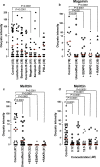Streamlined SMFA and mosquito dark-feeding regime significantly improve malaria transmission-blocking assay robustness and sensitivity
- PMID: 30683107
- PMCID: PMC6347765
- DOI: 10.1186/s12936-019-2663-8
Streamlined SMFA and mosquito dark-feeding regime significantly improve malaria transmission-blocking assay robustness and sensitivity
Abstract
Background: The development of malaria transmission-blocking strategies including the generation of malaria refractory mosquitoes to replace the wild populations through means of gene drives hold great promise. The standard membrane feeding assay (SMFA) that involves mosquito feeding on parasitized blood through an artificial membrane system is a vital tool for evaluating the efficacy of transmission-blocking interventions. However, despite the availability of several published protocols, the SMFA remains highly variable and broadly insensitive.
Methods: The SMFA protocol was optimized through coordinated culturing of Anopheles coluzzii mosquitoes and Plasmodium falciparum parasite coupled with placing mosquitoes under a strict dark regime before, during, and after the gametocyte feed.
Results: A detailed description of essential steps is provided toward synchronized generation of highly fit An. coluzzii mosquitoes and P. falciparum gametocytes in preparation for an SMFA. A dark-infection regime that emulates the natural vector-parasite interaction system is described, which results in a significant increase in the infection intensity and prevalence. Using this optimal SMFA pipeline, a series of putative transmission-blocking antimicrobial peptides (AMPs) were screened, confirming that melittin and magainin can interfere with P. falciparum development in the vector.
Conclusion: A robust SMFA protocol that enhances the evaluation of interventions targeting human malaria transmission in laboratory setting is reported. Melittin and magainin are identified as highly potent antiparasitic AMPs that can be used for the generation of refractory Anopheles gambiae mosquitoes.
Keywords: Anopheles coluzzii; Anopheles gambiae; Gametocyte; Gene drive; Malaria; Mosquito population replacement; Plasmodium falciparum; Standard membrane feeding assay.
Figures




Similar articles
-
The circadian clock modulates Anopheles gambiae infection with Plasmodium falciparum.PLoS One. 2022 Dec 1;17(12):e0278484. doi: 10.1371/journal.pone.0278484. eCollection 2022. PLoS One. 2022. PMID: 36454885 Free PMC article.
-
A randomized feasibility trial comparing four antimalarial drug regimens to induce Plasmodium falciparum gametocytemia in the controlled human malaria infection model.Elife. 2018 Feb 27;7:e31549. doi: 10.7554/eLife.31549. Elife. 2018. PMID: 29482720 Free PMC article. Clinical Trial.
-
Predicting transmission blocking potential of anti-malarial compounds in the Mosquito Feeding Assay using Plasmodium falciparum Male Gamete Inhibition Assay.Sci Rep. 2018 May 17;8(1):7764. doi: 10.1038/s41598-018-26125-w. Sci Rep. 2018. PMID: 29773818 Free PMC article.
-
Robust, reproducible, industrialized, standard membrane feeding assay for assessing the transmission blocking activity of vaccines and drugs against Plasmodium falciparum.Malar J. 2015 Apr 9;14:150. doi: 10.1186/s12936-015-0665-8. Malar J. 2015. PMID: 25890243 Free PMC article.
-
Epidemiology and infectivity of Plasmodium falciparum and Plasmodium vivax gametocytes in relation to malaria control and elimination.Clin Microbiol Rev. 2011 Apr;24(2):377-410. doi: 10.1128/CMR.00051-10. Clin Microbiol Rev. 2011. PMID: 21482730 Free PMC article. Review.
Cited by
-
Applications and evolution of melittin, the quintessential membrane active peptide.Biochem Pharmacol. 2021 Nov;193:114769. doi: 10.1016/j.bcp.2021.114769. Epub 2021 Sep 17. Biochem Pharmacol. 2021. PMID: 34543656 Free PMC article. Review.
-
Nanobody-mediated targeting of Plasmodium falciparum PfPIMMS43 can block malaria transmission in mosquitoes.Commun Biol. 2025 Apr 30;8(1):683. doi: 10.1038/s42003-025-08033-8. Commun Biol. 2025. PMID: 40301628 Free PMC article.
-
The circadian clock modulates Anopheles gambiae infection with Plasmodium falciparum.PLoS One. 2022 Dec 1;17(12):e0278484. doi: 10.1371/journal.pone.0278484. eCollection 2022. PLoS One. 2022. PMID: 36454885 Free PMC article.
-
Enrichment of phenotype among biological forms of Anopheles stephensi Liston through establishment of isofemale lines.Parasit Vectors. 2023 Feb 28;16(1):79. doi: 10.1186/s13071-023-05696-2. Parasit Vectors. 2023. PMID: 36855157 Free PMC article.
-
Melittin as a promising anti-protozoan peptide: current knowledge and future prospects.AMB Express. 2021 May 13;11(1):69. doi: 10.1186/s13568-021-01229-1. AMB Express. 2021. PMID: 33983454 Free PMC article. Review.
References
-
- World Health Organization. WHO. http://www.who.int/malaria/media/world-malaria-day-2018/en/. Accessed 01 July 2018.
-
- Nikolaeva D, Draper SJ, Biswas S. Toward the development of effective transmission-blocking vaccines for malaria. Expert Rev Vaccines. 2015;19:1–28. - PubMed
-
- WHO. UNITAID. Malaria Diagnostics Landscape Update Technical Report, 2015. https://unitaid.eu/assets/Malaria_Diagnostics_Landscape_Update_Fe_2015.pdf. Accessed 22 July 2018.

